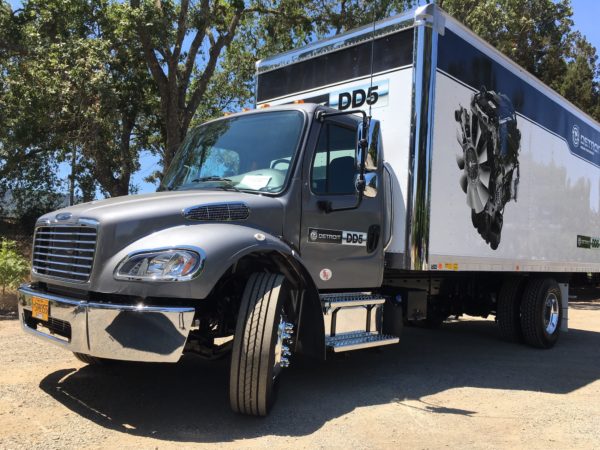Driving the Freightliner M2 106 with DD5 engine
YOUNTVILLE, Calif. — There will be skeptics. Detroit knows there will be skeptics. But the company’s bold move to challenge existing six-cylinder mid-range engines with a four-cylinder offering will deliver not only equal performance, but also benefits in terms of durability, serviceability and total cost of operation, the company contends.
And after an hour behind the wheel of a Freightliner M2 106 powered by Detroit’s new DD5 engine, I have to say the engineers who designed this engine have coaxed a surprising amount of power and performance out of the four-cylinder design.
Like many Daimler products, this engine was born in Europe three years ago but then extensively reconfigured for North American duty cycles. The company is taking a conservative approach to this market, initially offering the DD5 only in the Freightliner M2 106 and in certain stop-and-go applications. It will expand applications and power ratings – and will offer a larger DD8 – in 2018.

By introduction a mid-range engine to the North American market, Daimler feels it will bring the benefits of vertical integration enjoyed in the Class 8 segment – where more than 90% of its trucks are sold with Detroit engines – to the medium-duty market. Customers can now pair a Detroit engine along with Detroit axles. There’s no talk yet of a Detroit transmission for this segment but it seems a logical next step. The trucks made available for first drives contained Allison’s 2500 RDS transmission.
They also featured Detroit 10k front axles and 17.5k rear axles with a 5.71 rear axle ratio. Some were empty while one was loaded to 24,000 lbs. They were Class 6 trucks with 20-ft. dry van bodies.
On the road, the DD5 demonstrated snappy throttle response and little noise. Plastic bits can be found in key places on the engine to reduce noise. There was also considerable attention given to how the engine is mounted into the chassis, which reduces vibration inside the cab.
The DD5 has some unique attributes. It’s the first engine in the diesel engine space to use variable camshaft phasing (VCP), a feature that’s been borrowed from the passenger car segment and used by Detroit for the first time in a diesel engine.
This will contribute to more efficient aftertreatment, according to Chris Moran, program manager, who explained how it works in an interview with Truck News.
“With the new emissions systems, since we’ve gone to DPFs and SCR technology, some of the challenges, especially in P&D trucks, are when they’re empty or lightly loaded and you’re stop-and-go, it’s important to keep the aftertreatment system efficient in terms of burning off soot and NOx control,” Moran said. “One of the key things that VCP allows is, we’re able to open the exhaust valves sooner in the combustion process than we normally would, when you have more heat, so in effect you’re putting more heat into the aftertreatment system, which allows us to manage it more efficiently.”
This has enabled Detroit to extend DPF cleaning intervals to 200,000 miles or 321,000 kms, depending, of course, on duty cycle. Detroit is also including the aftertreatment system in its engine warranty.
The ability to compete with a six-cylinder engine and to get comparable power and torque out of four cylinders, came down largely to Detroit’s ability to manage the combustion process. It opted for a dual stage turbo rather than a variable geometry turbo to help with air management and in favor of simplicity.

Moran said the goal for engineers was to deliver equal performance to existing six-cylinder products, but greater fuel economy – 3% or more, Detroit claims – and improved durability. It is also promising longer service intervals: 45,000 miles/73,000 kms between oil and filter changes in short-haul applications. This, too, will drive down operating costs.
Detroit is touting a B10 life of 400,000 miles, which means only 10% of DD5 engines will need considerable work when they’ve reached that point.
“A lot of care has gone into making sure this engine is going to last,” Moran said.
The DD5 is initially being offered in two power ratings: 210 hp/575 lb.-ft. of torque and 230 hp/660 lb.-ft.
Have your say
This is a moderated forum. Comments will no longer be published unless they are accompanied by a first and last name and a verifiable email address. (Today's Trucking will not publish or share the email address.) Profane language and content deemed to be libelous, racist, or threatening in nature will not be published under any circumstances.
What is old is new again. I had 1994 FL106 with a DD Series 50 engine. This is not a European idea. My truck came with 320hp and was upgraded for free by DD to the emergency vehicle rating of 350Hp because of computer problems with the 320 version. This is simply the DD 60 series with two cylinders cut off, something Detroit Diesel and their old parent company GM did with just about everything the built. The “Bumble Bee” 4v71 and 6v71 being good examples.